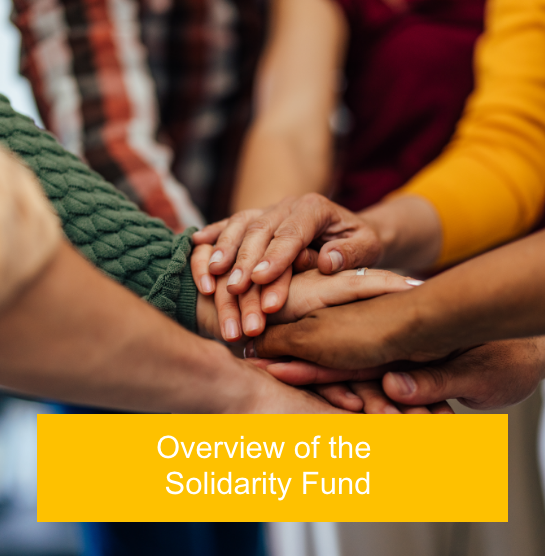How the Fund
was established
Establishment of the
Solidarity Fund
In early 2020, with the world facing the greatest health emergency in over a hundred years, at least 185 countries and territories reported instances of a highly contagious coronavirus, causing severe illness. SARS-CoV-2, wrought havoc with many falling ill with COVID-19, overwhelming health systems and having devastating effects on economies, lives and livelihoods.
The pandemic was confirmed to have spread to South Africa by Health Minister Zweli Mkhize on 5 March 2020, with the first known patient being a South African returning from Italy. As had been seen across the world, South Africa saw a rapid and alarming growth in cases over the following weeks. Weeks would turn into months; months would turn into years.
The South African government recognised that it needed to act fast to prevent the spread of the virus and limit the negative impact of the pandemic.
On 15 March 2020, the President, Cyril Ramaphosa, declared a national state of disaster, and announced measures such as immediate travel restrictions and the imminent closure of schools across the country. Two days later, President Ramaphosa established the National Command Centre on COVID-19. Initially championed by the Minister for Health, this group soon expanded to include various members of the cabinet, notably including Minister Tito Mboweni, the Minister for Finance, and Minister Ebrahim Patel, the Minister for Trade and Industry, who would serve as members of the Solidarity Fund’s Board of Directors.
On 16 March 2020, as the COVID-19 pandemic reached South African shores, leaders representing business, community, government, and labour held a special National Economic Development and Labour Council (NEDLAC) meeting. Both the business sector and the government tabled the idea of an independent, coordinated effort to face the storm heading our way. From there things moved rapidly.
In the week leading up to the 23 March 2020 and following the NEDLAC meeting, Martin Kingston, the Chairman of Business for South Africa (B4SA) and Minister Ebrahim Patel, Minister of Trade, Industry and Competition conceptualised the Fund. Martin Kingston also drove the mobilisation of resources to establish the Fund and get it operational as quickly as possible.
A key objective was to ensure that the Fund would be an independent and transparent entity, accountable to society at large. In this first week, the basic structure, focus areas and governance principles of the Fund were defined. Registration as a public benefit organisation began, a brand design and website were created, a bank account opened, and Gloria Serobe was named the Board Chair with Adrian Enthoven as Deputy Chair.
As soon as the Fund was announced, there was an outpouring of donations from South Africans of all walks of life, as well as international donors. The Fund’s leadership held their first daily war room meeting at 7.30am the day after the Fund was announced, a tradition that continued for most of the Fund’s existence. The first board meeting took place on 9 April 2020, by which time approximately R2bn had already been pledged to the Fund. Throughout the rest of April and early May 2020, a large number of volunteers worked tirelessly, donating their skills and commitment to finalising the Fund’s structure and establishing its subcommittees, operations, governance and controls.
The Fund was designed as an independent rapid response vehicle to fund impactful initiatives that augmented the national health response, contributed to a national humanitarian effort, and mobilised South Africans to act to stop the spread of the virus and to support their compatriots.
The Fund worked in close collaboration with government, business and civil society, but operated as a separate and independent entity. It would uphold transparency and strong principles of governance. It was a Fund for all South Africa.
Trust is central to success. Despite the enormous trust deficit in South Africa, through a combination of crisis, relationships, and radical transparency, the Solidarity Fund was able to galvanise capital and support for a newly formed, untested vehicle with no track record.
Clearly articulate the strategy and mandate before mobilising a Fund and ensure staff and the ecosystem of partners are familiar with the “true north” of the Fund.
It is imperative to have a strong representation of various sections of communities on the Board and Leadership to ensure solutions and programmes address the needs of society as a whole.
Clearly define the characteristics and behavioural traits that should be integral to leadership – this should be leveraged and used as guiding principles before onboarding new leaders.
Fund leaders should lead in an integrated manner, with inclusivity and ensuring all staff are well equipped and aware of the part they need to play to effectively execute the Fund’s mandate.
It is important that The Fund is more flexible when creating a mandate to ensure that it allows for agility and responsiveness to a defined set of crisis criteria.
It is important to consult with foundations who have dealt with similar activities before and learn from them when designing or updating new processes and procedures for an organisation.
Association with the presidency and highly regarded business people increased the attractiveness of the Fund for financial, in-kind and volunteer support.
Clear and publicised positioning as independent from government and business, and drawing its characteristics from an independent Board, is crucial.
Detailed scrutiny of supplier and beneficiary documents supporting spend in alignment with contracts is indispensable.




